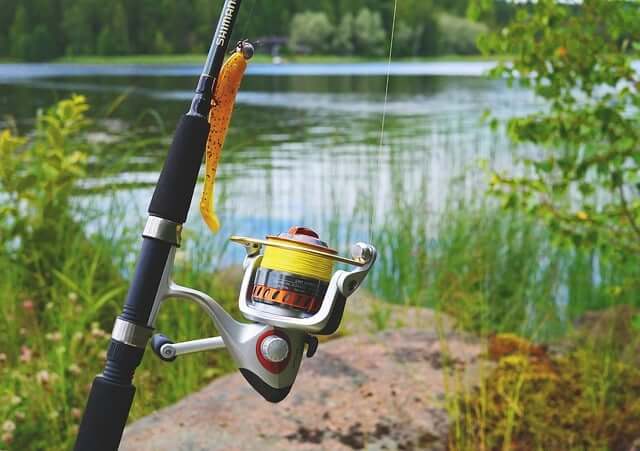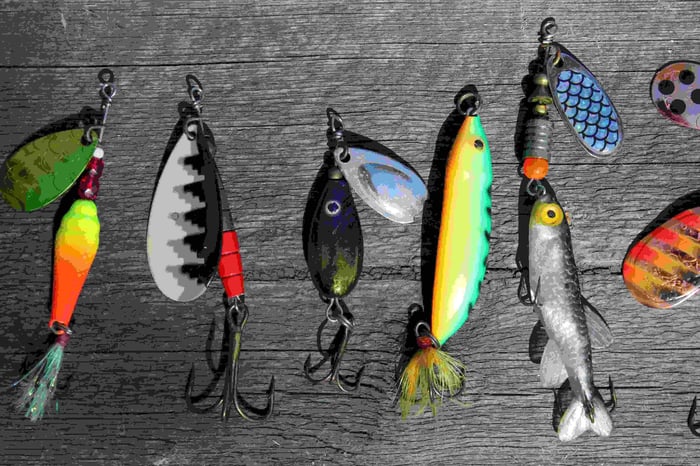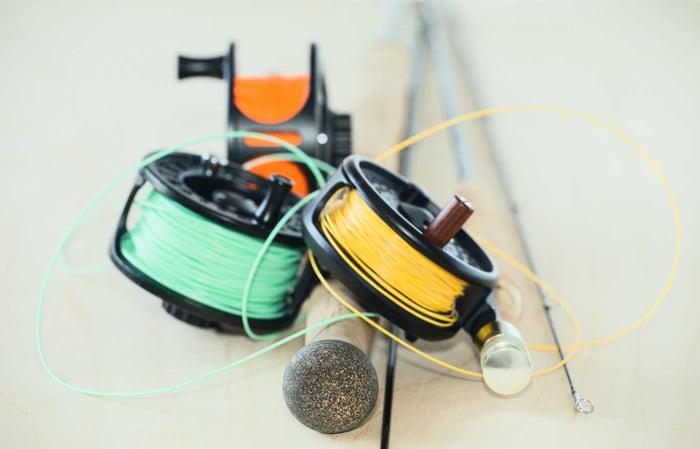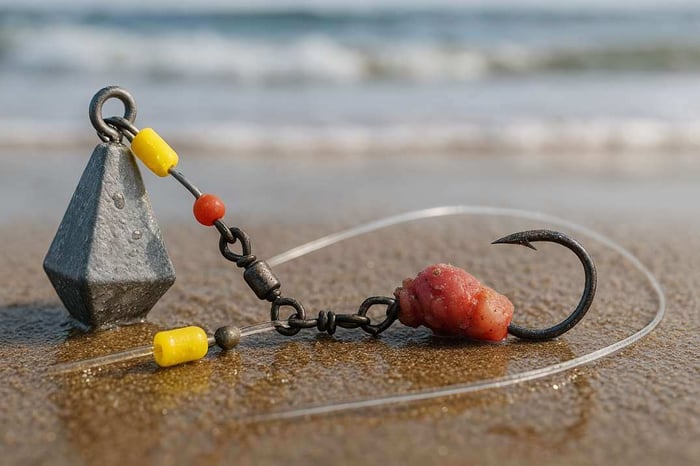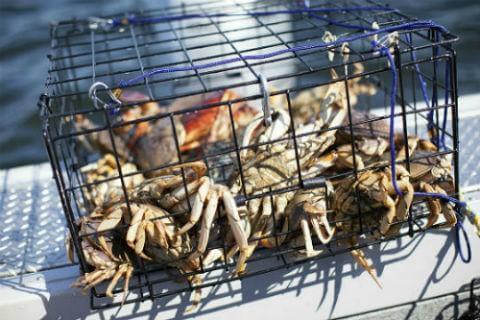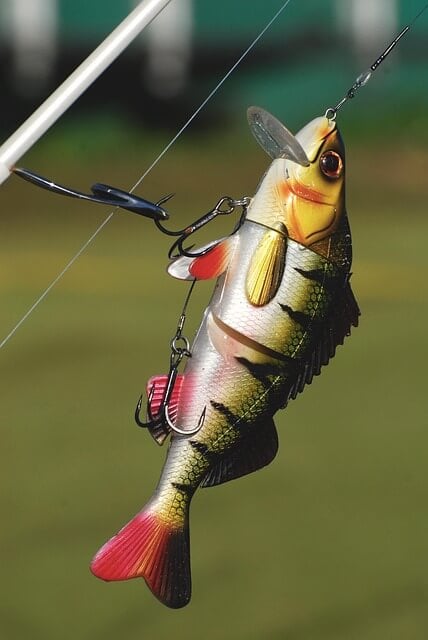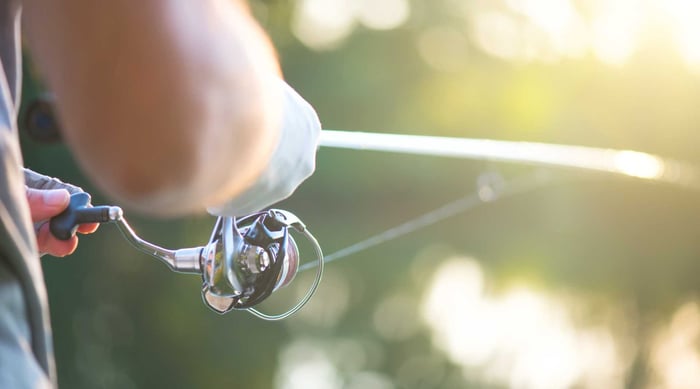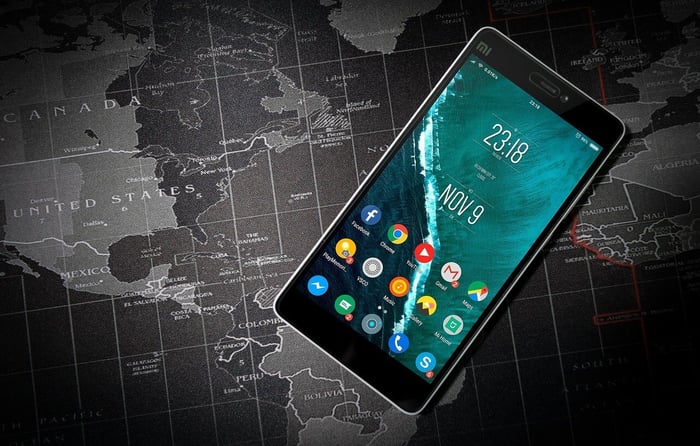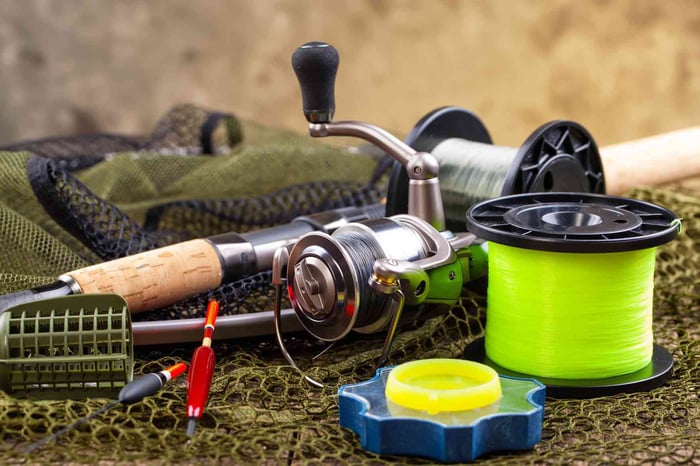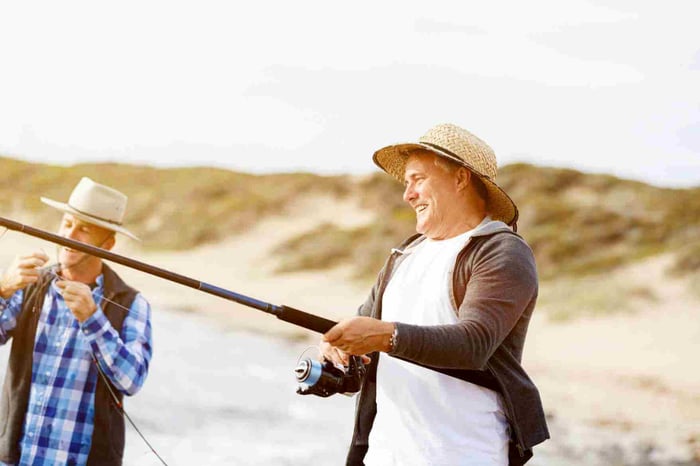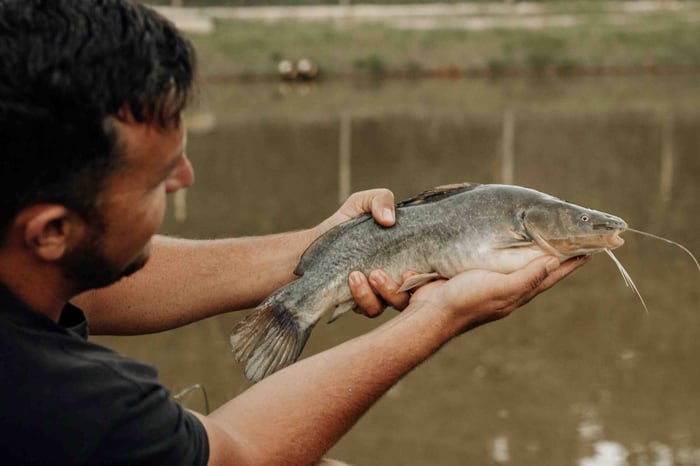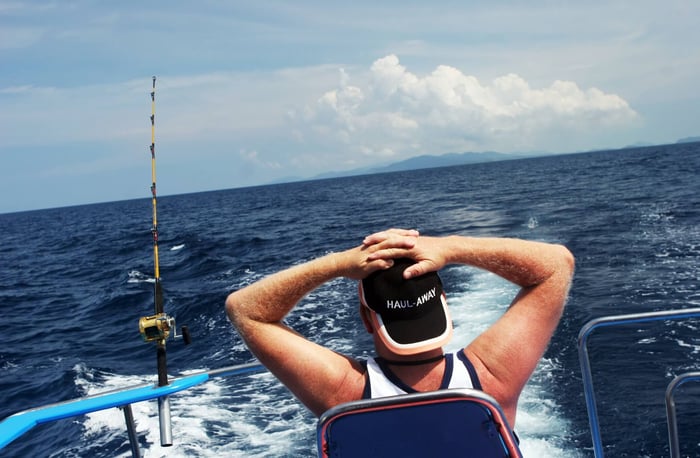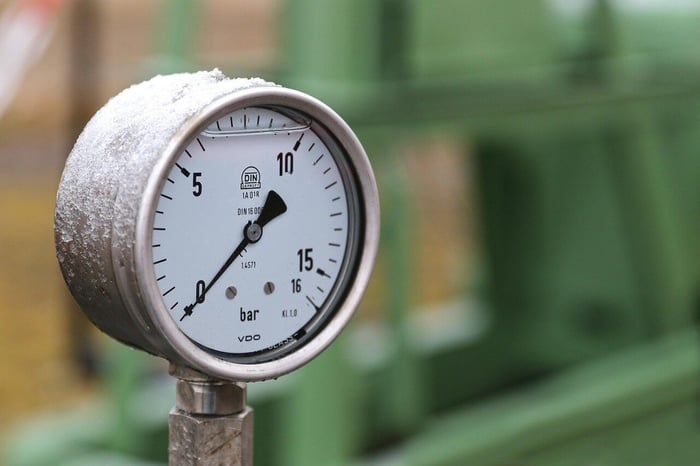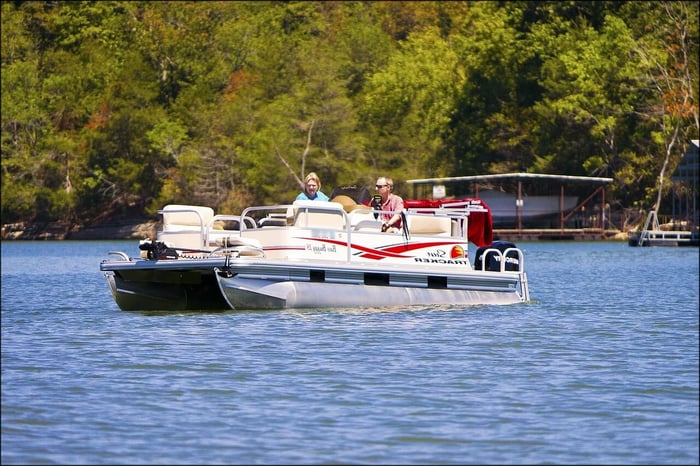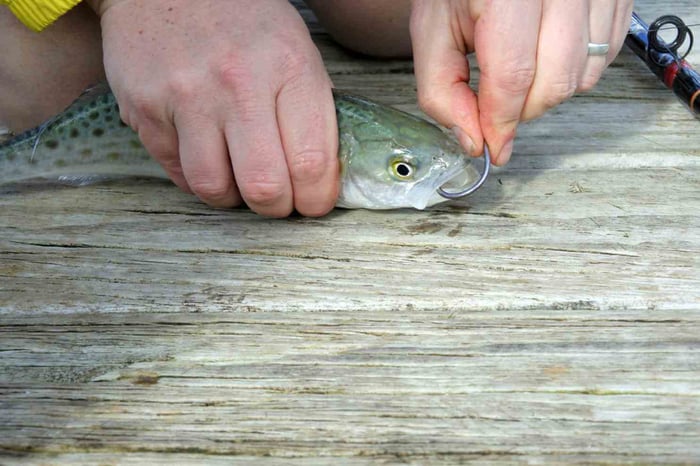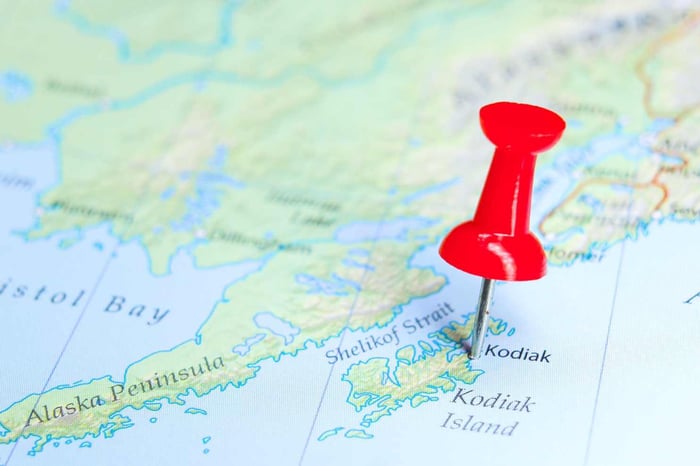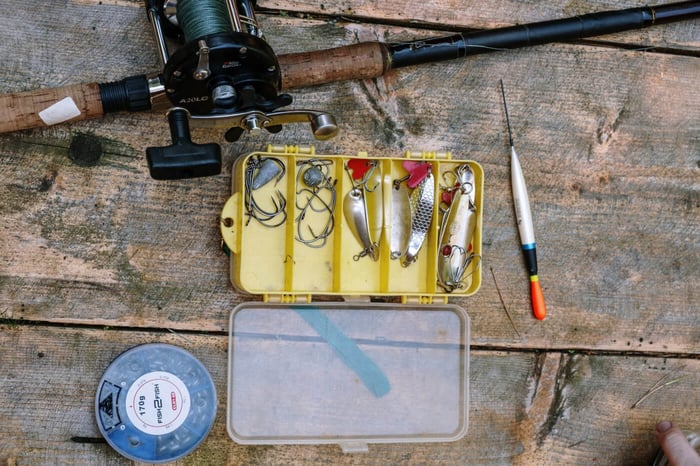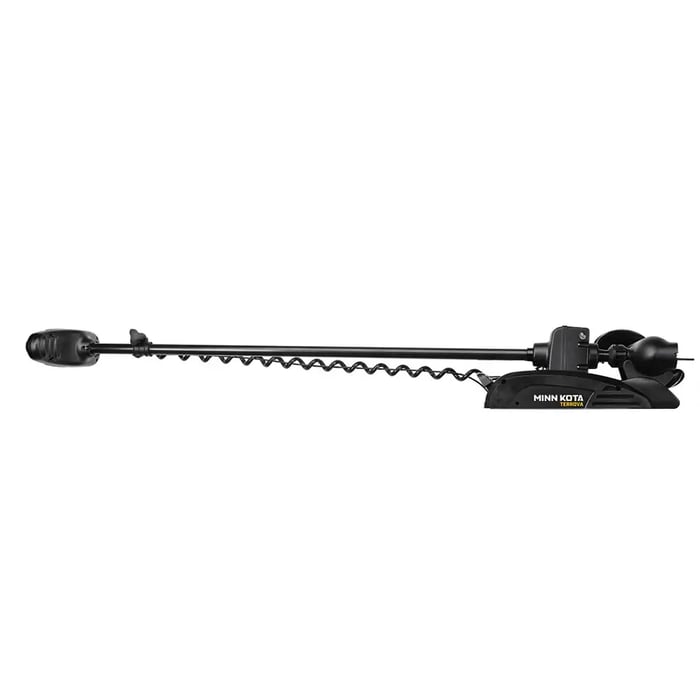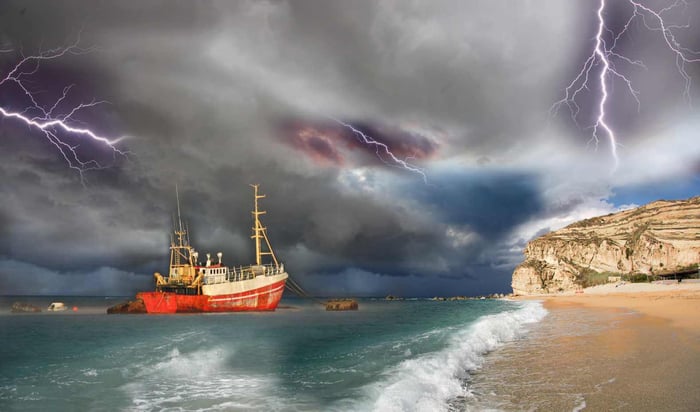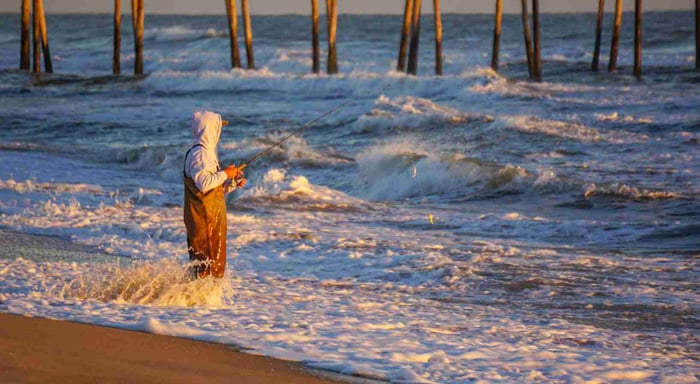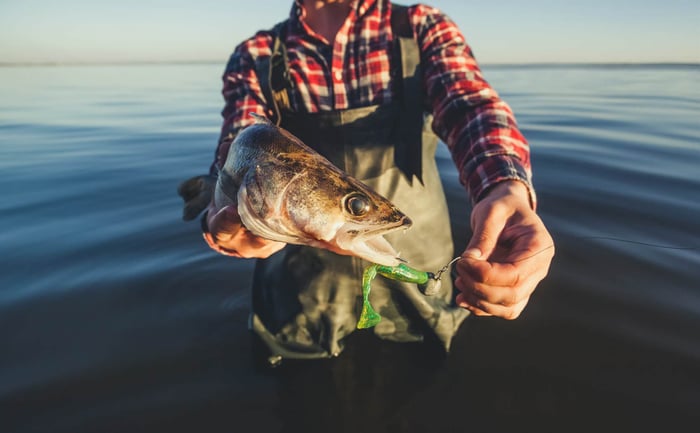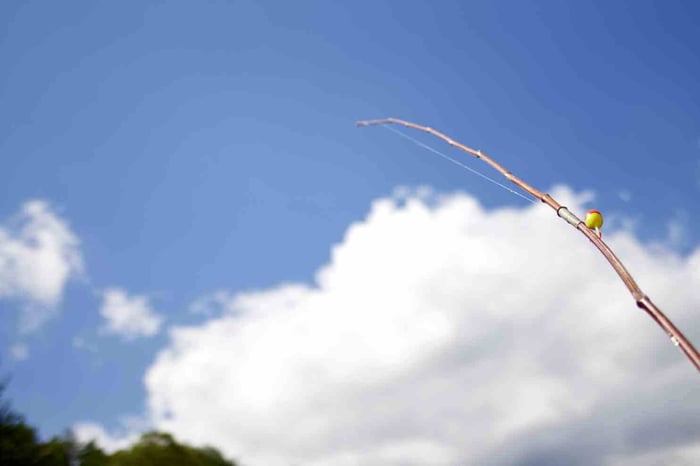Table of Contents
The Ultimate Fishing Reel Size Chart for Every Angler
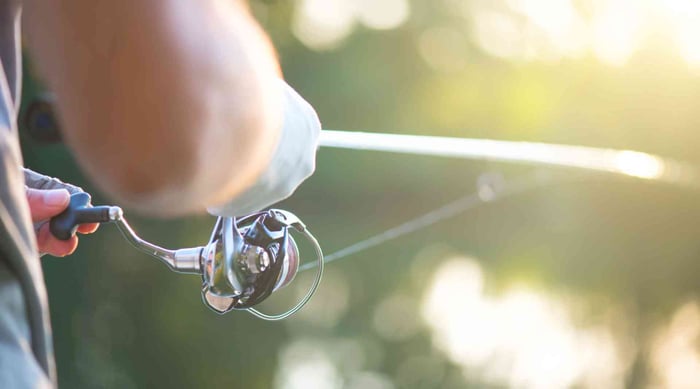
I know exactly how mind-blowing it is to stand in front of a wall of reels at the tackle shop.
I mean, you know how simple it is, but sometimes we can't help but let the numbers confuse us.
You grab one that looks like it should do the trick, go home, and the tool simply doesn't sit right on your rod. Too heavy. Or maybe the spool won't hold enough line.
We've all been there at least once, and it's aggravating. Trust me, I've been there, too.
One of the problems is that reel sizes aren't the same across brands.
A Shimano 2500 isn't always the same as a Daiwa 2500. Saltwater reels also look bigger even if they share the same number.
No wonder many beginners are confused, right?
But honestly, even old timers sometimes do head scratching and question whether they should go up or go down.
And that's why we put it together in this article. A table that says to you, in black and white: this reel size goes with this line, for these fish, in these purposes. That's it.
By the time you've read this, the numbers won't seem random. Hopefully, you'll be able to tell which reel is best for the fishing you'll be doing. So, read through the rest of the article.
What Do You Mean by Reel Sizes
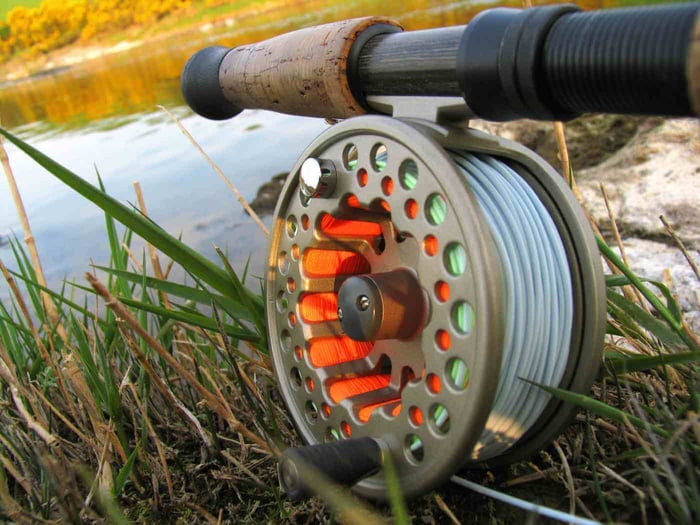
Reel sizes may seem confusing at first, and it's true.
If you notice 1000, 2500, or 5000, that's the reel size.
A 1000 is compact and lightweight and perfect for trout, crappie, or small fish in general.
A 2500 provides more line capacity and drag, making it suitable for bass or walleye.
A 5000 is made for heavier freshwater or light saltwater fishing, with sufficient spool capacity and strength for larger fish such as northern pike or redfish.
Other brands give them other names. This makes it extra confusing.
Shimano or Daiwa tend to stick with the 1000, 2000, 3000 system.
Some utilize two-digit numbers, such as 10, 20, or 30.
But just think. It's literally just the same principle. It's the scheme that counts.
The larger the number, the larger the spool, the heavier the drag system, and the more line you can hold.
So, when picking a reel size, think about what you’re actually going after.
Also, remember that line type plays a role. Light mono or fluoro takes up more space on the spool than braid, so you’ll need to check if there’s enough line capacity.
Target species matters too. Small reels make sense for panfish, but they won’t hold up on tuna or long runs from saltwater fish.
It also comes down to your setup.
A rod spinning with a 1000 reel is comfortable with light lures and rigs.
A baitcasting rod with a casting reel is best if you desire more control and a higher gear ratio for strength.
Spincast reels are easier, have fewer components, and a line release button, but they aren't designed for large fish.
Overhead reels and fly reels are also good, particularly if you enjoy manipulating fly line with a disc drag fly reel.
Obviously, there is no one-size-fits-all here. Reel size varies for many reasons: fish, water, line weight, and feeling comfortable in your hands.
Seasoned anglers recognize that the balance of reel, rod, and style is what gets the task done. Take it from them if you want to catch more.
The Chart
What most anglers really want to know is the reel size to pick up for the type of fishing they want to target. That's where a fishing reel size chart comes in handy.
Below is a comparison we've compiled after double-checking sizes throughout Shimano, Penn, Daiwa, and Abu Garcia.
It addresses spinning reels, baitcasting reels, and even fly reels so you can match up the proper reel with your rod, line, and target species. Hopefully, the chart below helps!
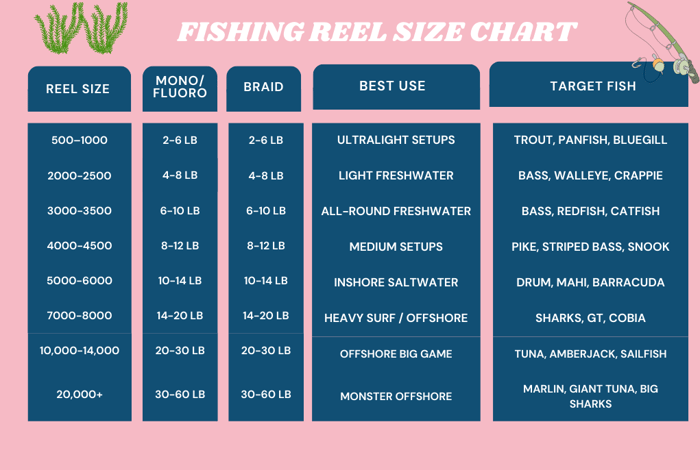
First, let's talk about what you really want to catch.
If you want to catch a trout in streams, a 1000 with light tackle is more than sufficient.
You'll have finer control over tiny baits, and the spool turns smoothly on the reel.
And trust me, it won't get tired carrying additional weight.
For largemouth bass, most anglers prefer a 2500 or 3000 because it provides them with sufficient line capacity for extended casts. The good news is, it actually remains light in a spinning rod.
If you're saltwater fishing, it's a fast switch.
Saltwater reels require more drag settings. Not just that, you also need a bit tougher internal components as fish take longer runs.
A 5000 spinning reel or 6000 casting reel can accommodate larger baits and apply more casting distance from the beach or jetty.
When you get into tuna or other offshore species, you're talking 10,000 and beyond. With this, of course, you will also need a rod that can accommodate heavy line weight.
• Spinning Reels
Spinning reels are the most popular and suit nearly everything, from trout fishing to surf casting.
They employ a fixed spool and line roller to keep the line evenly spread around the spool.
They're simple to use and provide constant drag. Plus, it just allows you to cast light lures far.
• Baitcasting Reels
Baitcasting reels are unique, I'd have to say.
The spool spins during casting, giving you additional control and a larger gear ratio for power.
But they require practice, too. That's the thing.
Without an adequate braking system or drag setting, you'll have a bird's nest of mangled line. That's honestly such a hassle if you're already out there.
Nevertheless, for experienced anglers pursuing bass, pike, or saltwater species, a good baitcasting reel provides superior control.
It also gives you additional line capacity in a compact design. Double win, I guess.
• Spincast Reels
Spincast reels are the least complicated. Press the line release button, cast, and begin reeling.
They're easy to handle, lightweight, and have fewer components to concern yourself with.
They're good enough for small fish, but they won't give you the casting range or drag strength of a spinning reel. Consider that when taking your pick.
• Fly Fishing Reels
Fly fishing reels occupy a class by themselves.
They’re sized by fly line weight rather than numbers like 2500 or 4000.
A 5-weight fly reel is perfect for trout, while a 9-weight fly reel with a strong disc drag is what you’d want for bonefish or even light saltwater.
Fly fishing reels are straightforward, with a spool release to swap spools quickly.
However, please note that the drag system must be smooth enough for extended runs. Just a little bit of a reminder.
• Overhead Reels
Overhead reels (or so-called conventional reels) are also noteworthy for offshore fishing.
They're designed for large line sizes, additional line, and heavy power when looking to catch tuna or bigger fish.
They won't appear on the same fishing reel size chart as spinning reels, but they're an important part of the fishing industry. So, perhaps you'll need this someday. Who knows?
What's The Reel Size For You
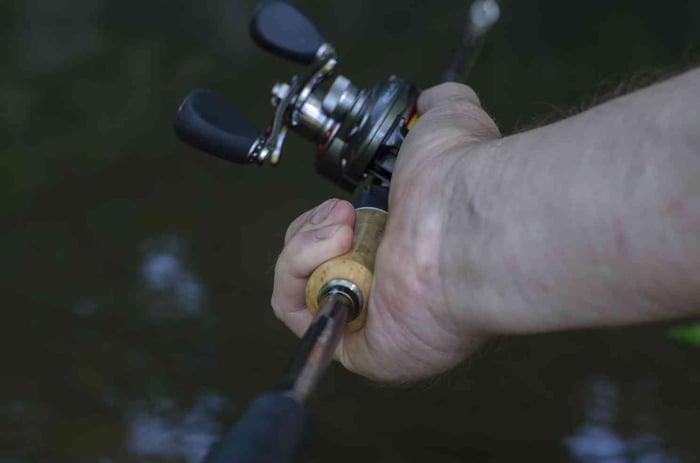
A reel has to feel balanced on the rod.
Rod Size
Put a 6000 on a light spinning rod, and you’ll notice right away it feels off.
The setup drags in your hands, the tip loads wrong, and casting feels like work.
On the other side, a tiny 1000 reel on a heavy rod won’t have enough line capacity, and you’ll run out of power when a larger fish makes a long run.
The best setups always match rod and reel. That's just the general rule.
Line Strength
Line strength matters, too. Overfilling a 1000 reel with 20-pound braid is a recipe for line twist and headaches.
The thing is, the reel’s spool just isn’t designed for that kind of pressure.
Go with a line weight that makes sense for the reel size, and you’ll have fewer problems and more consistent drag. Trust me, that's a big "relief" when you're already out there.
Lure Weight
The weight of the lure is the second part of the equation.
Small trout lures are easier to cast with light tackle and smaller spools.
A 3-ounce popper or weighty jig requires a larger spool spinning reel or even a casting reel with a braking mechanism powerful enough to hold the spool at bay.
Forcing heavy lures onto a small reel only damages distance and accuracy casting.
Location
Location also directs you towards the proper size.
Small lakes and ponds are where 1000 to 2500 reels excel. Rivers and estuaries require a flow rate between 2500 and 4000.
If you're fishing the surf or piers, you're going to need a 4000 to 6000 with sufficient spool room to cast long and fight powerful currents. Offshore is another story, honestly.
That's where 8000 and up are in order. It gives you "enough" drag and additional line to stay with tuna or other big fish.
Just think of it this way. If you're going to catch schoolie stripers with a 7-foot medium-heavy spinning rod, a 4000 spinning reel is home sweet home. Chief's kiss!
You'll have greater control, sufficient line to manipulate lures, and a rig that won't beat you up.
Selecting reel size is more a matter of ensuring your rod, reel, and style of fishing are compatible. ALL compatible, I repeat.
They need to complement MORE than the digits on a fishing reel size chart.
When they're compatible, the entire experience is natural. And hassle-free, at that.
Here’s Where Things Get Tricky
This has already been mentioned above, but the truth is, reel sizes aren't always equivalent between brands.
A Shimano 2500 doesn't equate perfectly to a Daiwa 2000.
Penn reels, such as the Battle series, are built heavier, so a Penn 4000 feels more like a Shimano Stradic 5000.
Saltwater reels in general weigh more, with heavier drag systems and more internal parts to resist corrosion.
That's why you can't simply look at the reel size number and decide.
Always inspect the actual line capacity, the spool size on the reel, and the drag rating.
A reel with evenly wrapped line, a well-lubricated line roller, and uniform drag informs you more about what it will take than the number on the box.
Various reel styles put on more layers. An equivalent-sized baitcasting reel won't take as much line as a fixed spool spinning reel. However, it will provide a more gear ratio and control for certain lures.
A spincast reel with a line release button is lighter and has less hardware, but it's not designed for longer casting distances or bigger fish.
To add, offshore overhead reels possess the power offshore. While fly fishing reels are sized by fly line weight rather than numbers. Plus, they have disc drag systems to preserve tippets on long runs.
Seasoned fishermen in the sportfishing business are well familiar with these differences.
A fly reel with a quality disc drag is light-years apart from a casting reel for tuna.
A spincast works okay for small fish, but it will never come close to what today's spinning reel can do. If you need long casts or reliable drag adjustment for your next trip, just take note of this.
Again, reel size is a guideline, but you still have to look closer. Line size, drag, and feel on your rod are something to check out.
Pay attention to the little things, such as the braking system, the spool release, and internal factors.
That's how you make an educated choice rather than guessing a number. This can really make or break your next trip.
What Other Anglers Are Saying...
On pocket water and small creeks, a light rig is ideal.
Tackle Tactics suggests an Okuma IXT 1000 spinning reel on a 6-foot ultralight rod loaded with around 4 to 6-pound mono.
That combination allows you to cast small lures and make a lot of precise casts.
It is the type of rig trout anglers use when they want "control" over brute strength.
For inshore and kayak fishing, the equipment ramps up slightly.
SaltStrong discusses 3000 series spinning reels on a 7-foot 6-inch medium-heavy rod when pursuing redfish and similar species.
Most kayak bass fishermen dial that back a little to a 2500 reel on a 7-foot medium rod with 10-pound fluorocarbon or braid.
Those configurations provide sufficient line capacity for extended casts and the occasional brutal run without being too complicated on the paddle craft.
Surf fishing drives spool size and line weight up. Battlbox and regional surf writers demonstrate that a 4000 to 6000 spinning reel on a 10 to 12-foot surf rod is the typical combination.
Nick Heid of Surf Fishing SoCal SD sometimes recommends reels such as the Penn Battle 4000 or a Spinfisher 4500, paired with 20- to 30-pound braid.
The idea really is to just have enough line for extended casts and be resistant to larger waves and large fish runs.
Offshore fishing is another animal. Tuna and amberjack anglers employ big conventional or big spinning reels in the 10,000 to 14,000 range and heavy rods with 60-pound braid or better.
Those setups are designed for long runs and hard fights.
They aren't ideal for small baits or all-day shore trips, but they get it done on big water.
Mismatching reel size appears quickly on the water.
A reel that is too small will be out of line or have its drag adjusted to max on a long run, and you lose fish.
But at the same time, a reel that is too large makes the entire setup heavy and fatiguing, and it really gets bad casting with light lures.
At their core, what they're saying is pretty much the same. Match the reel to the rod and the fish you wish to catch.
More Thoughts
Most anglers end up buying reels that are larger than necessary. It's honestly such a waste.
They think that a 6000 will do everything "just in case." What ends up happening is a bulky rig that weighs you down after a handful of casts.
You sacrifice sensitivity, and the worst part is, you don't get to have fun anymore.
Another mistake is ignoring line ratings. They're there for a reason, you know?
A 1000-reel loaded with 20 lb braid is a formula for wind knots and poor line lay.
The line spool and drag system is designed for specific ranges.
And really, exceeding that makes fishing more difficult, not less.
Rod balance is also forgotten. Combine a small ultralight rod with a large saltwater reel and you're off balance. This will instantly make your fishing experience bad.
The entire combo feels complicated, and you lose casting range.
On the other hand, a small reel on a heavy rod looks and feels kinda...weird.
Others also believe bigger is better in terms of quality. A lower-end 4000 spinning reel will not outcatch a well-constructed 2500 with smooth drag and good internal components.
But hey, reel size is only half the consideration. How a reel is built is just as important. Remember that for next time. There's always time to learn more.
